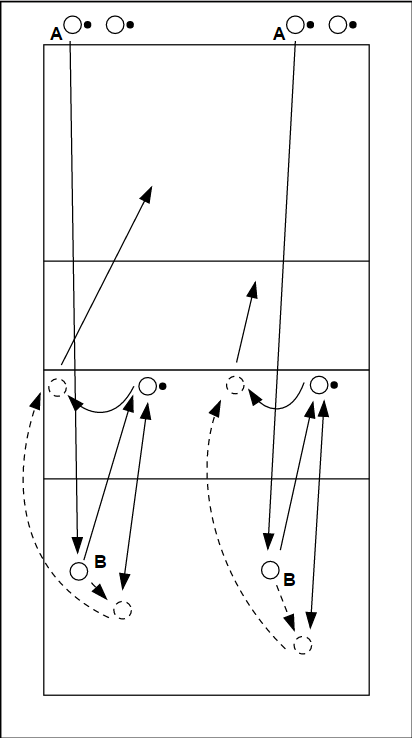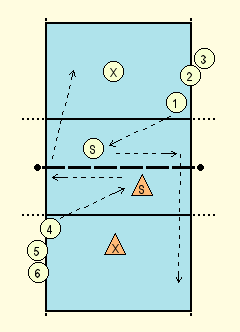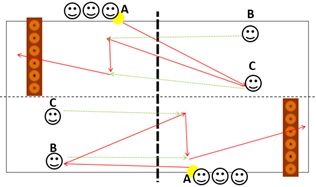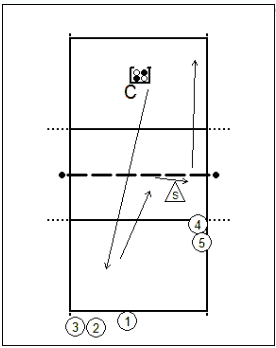Volleyball drills for technique attack / smash / spike / hitting
- Players face each other at the net
- They take turns to play a technical attack over the net.
- Each time, they take a step backwards until the technical attack evolves into a serve.
- If the ball goes awry : start again from the beginning.
- A player initially stands on position 6
- from the moment the first ball for attack is given on the other side, the player shifts to the back,
- Attacker plays the ball deep at position 1 or 5. Player defends the ball to the receiver (T).
- When 3 balls are good, they move on.
- With tennis balls try to throw as far as possible à right foot in front, arm yourself
- One person throws a tennisball, the other catches it in an upside down cone. Ã right foot forward, arm yourself
- The players take turns throwing a tennis ball against the wall and above a certain line. They try to score in the area marked off by the cones.
Two sides of the net are used.
- Player 1 stands at one side of the net, throws up the ball and hits it to player 2, who stands in a service-pass position;
- It is important to use the right technique when hitting the ball;
- Player 2 passes the ball to the trainer;
- Player 2 passes the ball to the trainer; pay attention to the passing to the desired set position;
- The trainer catches the ball and throws it immediately in a perfect setup (start with a 1m set which contains a peak);
- Player 2 gets into position for the attack, and attacks in a specific area (use pawns as targets);
- After the attack, the player advances to the serving position;
- After player 1 hits the ball, he connects behind the line of passers/attackers.
- row of attackers and 2 blockers at the other side at the net
- Trainer throws the ball to the attacker from the side of the block.
- Attacker hits ball into the block
- Attacker gets the ball, connect behind your own line.
- After 3 attacks change with the block.
- 2 against 2
- Trainer throws/strikes the ball from the side.
- 2nd ball obligatory overhead,
- attack punched.
- Defense etc.
- Loser leaves the field,
- Winner changes half.
- A serves to B.
- B passes the ball to the playmaker, who then plays a high ball into the backfield.
- B defends this ball back to the playmaker, who then gives a setup for A.
- A attacks on this setup.
After the attack, A takes B's place and B becomes a reserve. The playmaker stays.
The outfield attackers use the left half of the court with one playmaker. The middle attackers and diagonal attackers use the right half with another playmaker.
Extension:
- After the service, A takes a second ball.
- After B's attack A throws this ball into the field.
- B plays this ball to the playmaker, the playmaker gives a setup.
- B attacks again.

- Attacking from outside on two pitches.
- Players pay attention to their run-up and both arms.
- After that attack the middle of two fields.
- Then 3 players in field B defend and 3 players in field A attack.
- Coach throws ball to trio in field A.
- Pass, set up, attack.
- If trio in field B defends or hits the ball well, we switch.
- Players in field A go to field B and new trio goes on reserve attack.
- Otherwise the defense stays.
Trainer throws ball to defender, there are 3 rows of attackers at position 2, 3 and 4 ready. SV chooses a striker. Attackers pay attention to their run-up and arms.

The purpose of the exercise is twofold: the defender must learn to 'read' where the attacker is going to hit and the attacker must look where the defence is before hitting.
We work with two regular playmakers, on both sides of the field a row of attackers on the left-for position. And two defenders, who may choose where they position themselves on the field. A defender has to defend the attack 10 times, preferably a nice pass, but touching is enough. If the attacker hits the net or leaves the field, that also counts. And the attackers may only smash, no prick balls! After the attack, the attacker retrieves the ball and joins the other row. The attacker who defends the ball at the 10th time takes the place of the defender. The defender will then of course attack.
Necessary:
- 8 - 10 players
- enough balls
If there are less players, the exercise can also be done, but then on one side. The attacker retrieves the ball and joins the same line.
The blocker joins in, indicates where he is going to block and the mid-back goes to his place.
- Player A throws ball over the net.
- Player B or C passes ball to other player
- The other player quickly runs to the net and sets up the ball for the same player who passed.
- This player tries to get a pawn off the bench with overhand play or a hitting move.
- Change after 5 balls
Which pair or team has knocked off/handled the most pawns after X number of minutes?

- Player A throws ball over the net.
- Player B or C passes the ball over the net.
- The other player quickly runs under the net and sets up the ball for the same player who passed.
- This player tries to get a pawn off the bench with overhand play or a hitting move.
Which pair or team has knocked the most pawns off the bench after X number of minutes?

- 1 defender starts behind the back line - C plays high ball in the field - 1 comes in and plays overhead to S - S sets up backwards to 4 - attack straight ahead, attacker gets the ball - 1 becomes attacker and 2 defender
SETS UP THE BASKET (BLOCK IDEA)







